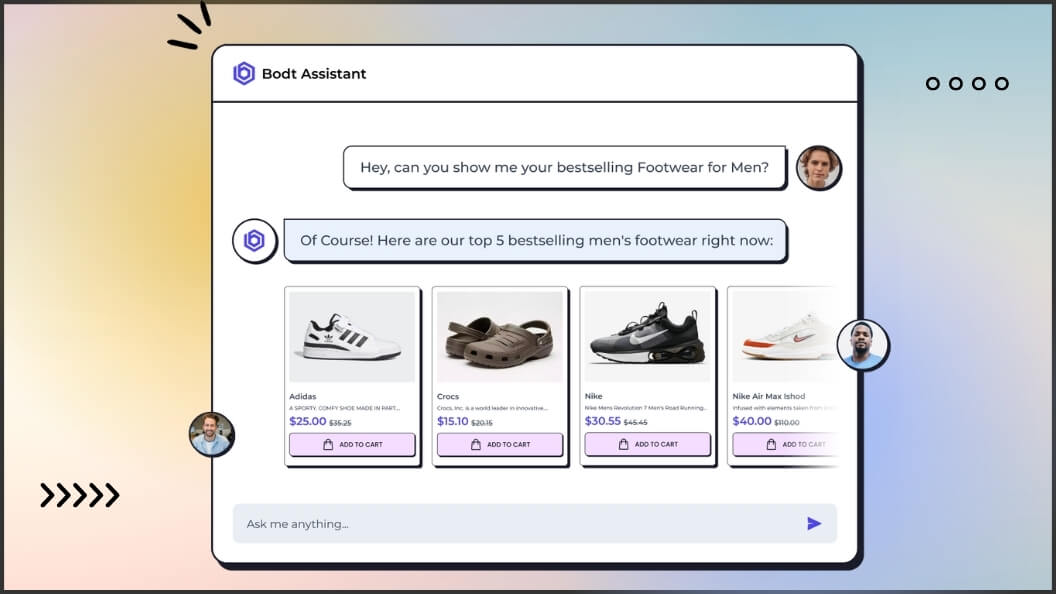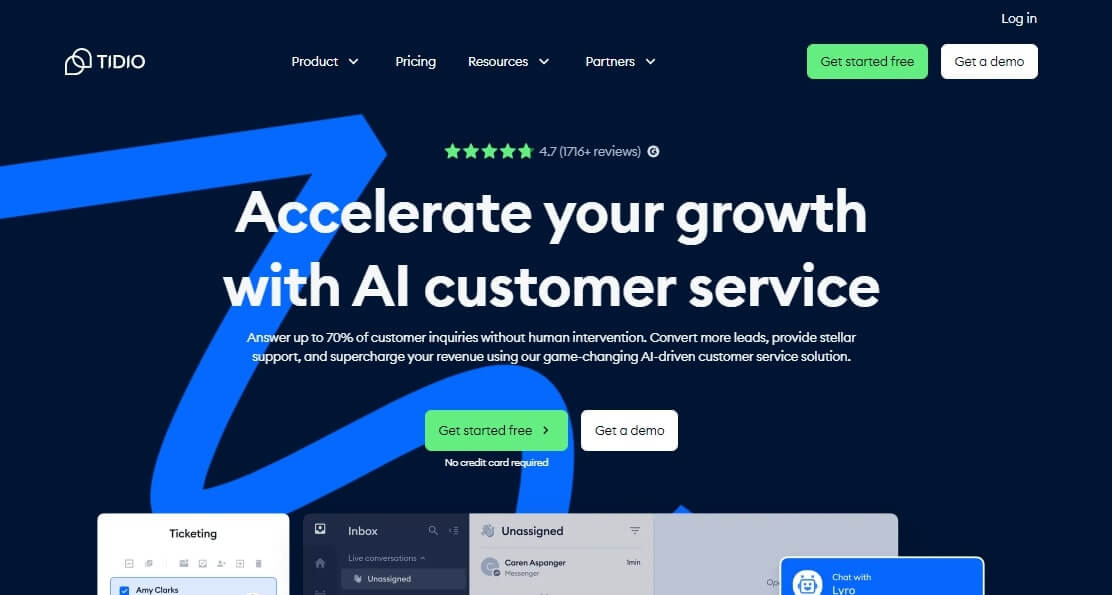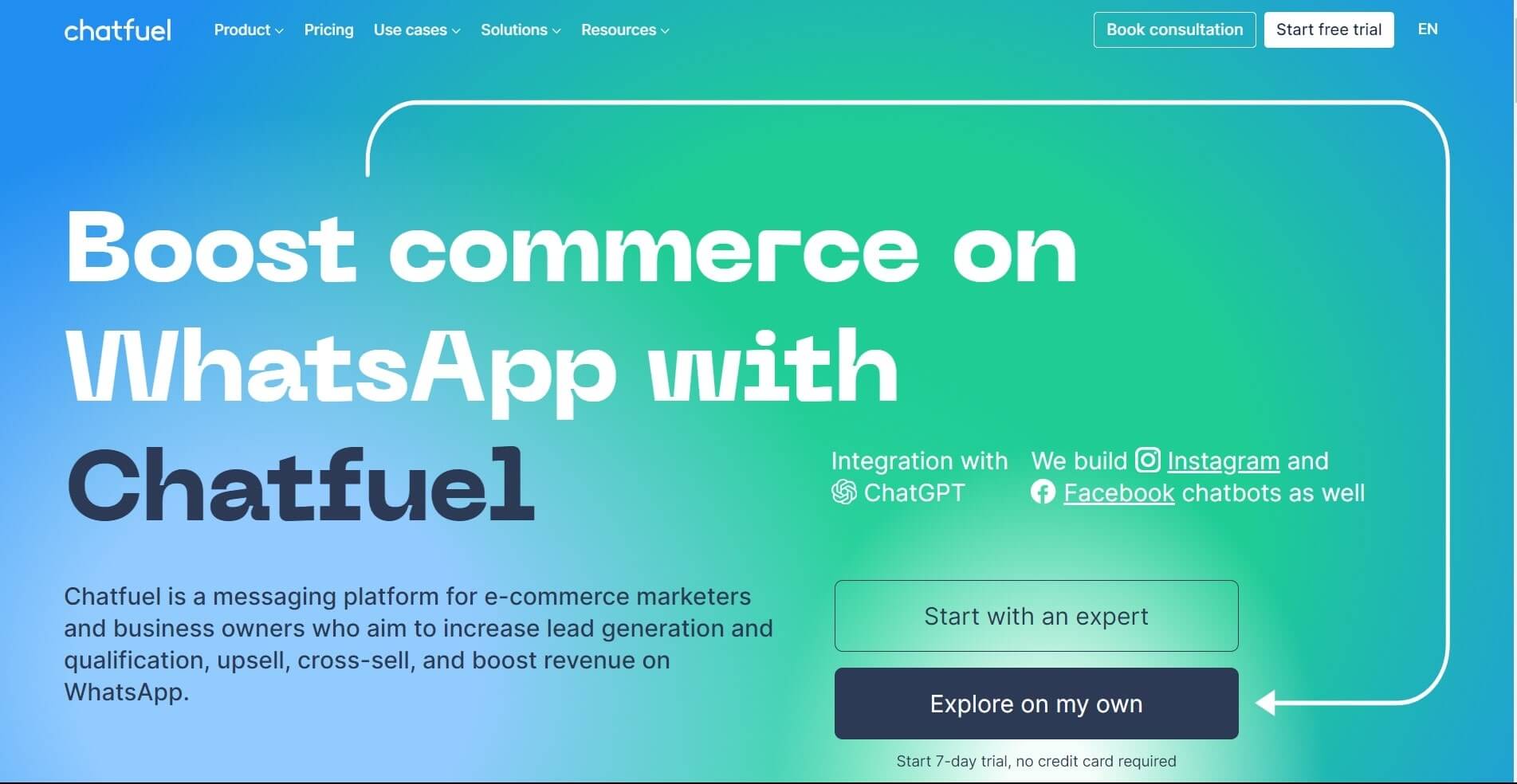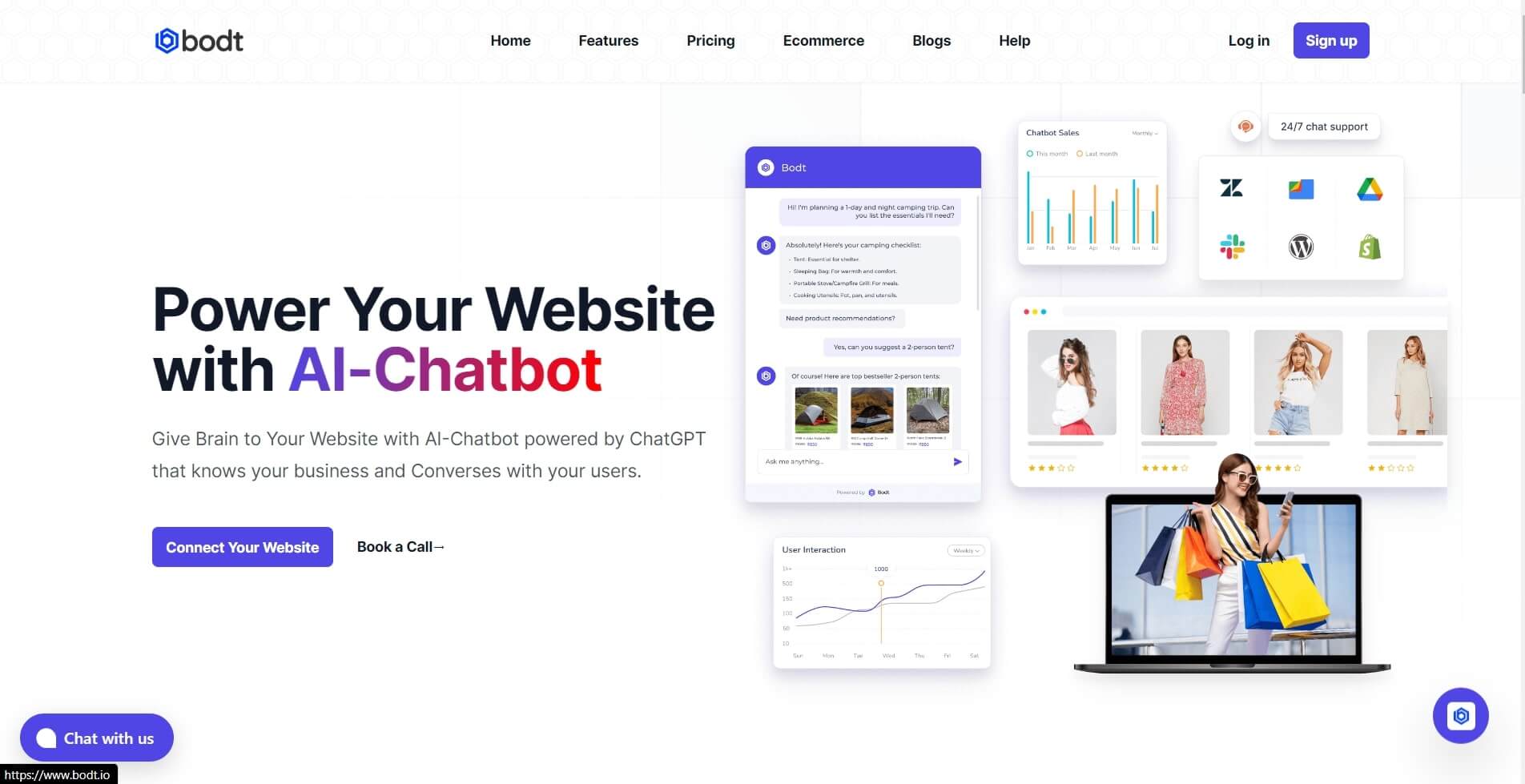
In recent years, the use of chatbots in online shopping has surged, contributing to more people purchasing online items. Now, picture yourself shopping for a couch in the evening. It's 8 PM, and there's no one available to answer your questions. Suddenly, a shopping chatbot pops up and gives you all the necessary information. Thanks to the chatbot, you can buy your couch without waiting days for an email response. Amazing right? That's how easy buying from the internet has become because of these chatbots.
So, what's causing the ecommerce chatbot market to grow so much, expected to hit $1.25 billion by 2025? It comes down to three main factors: cost savings, enhanced customer service, and efficient management of interactions across different platforms. Meanwhile, there are lots of chatbots you can use for your ecommerce stores like Bodt, Tidio, Chatfuel, and the list is endless. In this guide, we'll take you through everything you need to know about sales chatbots, their benefits, and how to integrate them into your ecommerce store.
The Rise of Shopping Chatbots
Most times, businesses struggle to promptly respond to customer questions and concerns. Using a chatbot for sales was identified as an effective solution to these problems. At the moment, many employees are tasked with answering live chat questions. But, the task can be lessened if these businesses automate their live chat with a chatbot.
Also, eCommerce benefits greatly from chatbots because most of the customer journey until delivery, takes place on mobile devices. So, chatbots are always available 24/7 to recommend products or special offers and answer any questions they might have.
If a customer asks a question that the sales chatbot can't answer, it will quickly connect them to an agent. Actually, using chatbots as the first point of contact helps gather information for agents, making the process more efficient and saving resources while keeping the human touch.
Why Use Chatbots in E-commerce?
There are so many chatbot benefits for business. Some of them include:
Instant Customer Service and Reduced Wait Time
Most e-commerce businesses have customer support teams. However, they receive orders from around the world, with buyers in various time zones. This makes it challenging to provide timely support during off-hours. By using chatbots for sales on their websites, companies can offer consistent, high-quality customer service 24/7. They can respond to common questions and guide shoppers to the information they need, enhancing their experience and increasing the likelihood of a purchase.
Increased Sales Through Proactive Customer Engagement
Improving customer experiences is key to boosting sales. The better the experience you provide, the more likely customers are to return and make purchases. So, why use chatbots? This is because good experiences build loyalty, and chatbots are essential for enhancing these experiences. They allow you to be available 24/7, overcome language barriers, and respond almost instantly, all of which are important for great customer service.
Cost-effective Compared to Traditional Customer Support
Customer service is essential for businesses, but e-commerce chatbots can make it more efficient and cost-effective. Chatbots can manage many customer interactions at once, lowering the need for a large customer service team. They can also address each customer's questions individually without requiring a workforce. This efficiency can greatly benefit your business's profits, leading to substantial cost savings.
Chatbot for Sales: Enhancing Customer Interaction
The use of chatbots for sales is transforming the way businesses interact with customers. These AI-powered assistants are changing the shopping experience by acting as virtual sales agents, offering lots of features that make online shopping smoother and more efficient. These features include:
Lead Capturing
One of the standout features of a chatbot for sales is lead capturing. Imagine visiting an online store and having a chatbot pop up to ask how it can help. This friendly assistant can gather your contact information and preferences, ensuring you get personalized service right from the start. It can even follow up with you, increasing the chances of turning a casual browser into a loyal customer.
Product Recommendations
This is another useful feature that a chatbot for sales provides. By analyzing customer data and browsing history, chatbots can suggest items that you'll normally prefer. For instance, if you're looking at a particular dress, the chatbot can recommend matching accessories or similar styles. This personalized approach not only enhances the shopping experience but also boosts sales by showing customers exactly what they want.
Automated Checkout Processes
The automated checkout process is another feature that proves the usefulness of chatbot shopping assistants. These bots can guide customers throughout their purchase journey, from adding items to the cart to making the payment. Also, they answer any questions about the shipping options or return policies that apply.
For example, a customer shopping for a new phone can use a chatbot to compare different models, get detailed specs, and finally, proceed to checkout, all without needing to speak to a human.
In-depth Analysis of Top 3 E-commerce Chatbots
It is a known fact that e-commerce chatbots have become indispensable tools for businesses. They help with customer interactions, boost sales, and enhance the shopping experience. So, how do you know which one to use? Let's take a look at some chatbots for sales, you can always try out. They include:
Tidio

Tidio is a complete customer service chatbot platform that has a no-code bot builder and live chat.
Features
- Lyro AI assistant uses natural language
- Over 30 chatbot templates available
- Customizable FAQ bots for any business type
- Various chat triggers to choose from
- Integrations with Instagram, Zapier, Facebook, and more
- Mobile app for iOS and Android
Benefits
- Live Chat and Chatbots Tidio combines live chat with chatbot capabilities, allowing businesses to offer immediate support and automated responses simultaneously.
- 24/7 Customer Support With Tidio, customers can get answers to their questions any time of the day, which is important for businesses with a global audience.
- Cost Reduction Live chat helps cut down your business expenses. They focus on small and midsize businesses, so you don't have to spend money growing your customer service team.
How Tidio Integrates with E-commerce Platforms
Tidio integrates with major e-commerce platforms like Shopify, WooCommerce, and BigCommerce. This integration allows businesses to easily manage their online store and chatbot from a single dashboard. For example, Tidio can automatically pull product information from the store and use it to answer customer questions or make personalized recommendations.
Chatfuel

Chatfuel is a top AI chatbot for eCommerce customer service, ideal for store owners seeking omnichannel support.
Features
- User-friendly Interface
- Contact customers via Facebook, Instagram, and your website using Chatfuel.
- Chatfuel can handle 98% of customer inquiries, saving you time and reducing the number of questions you need to answer
- Set up pre-made responses for FAQs to avoid repetitive questions
Examples of Successful Integration in Real Businesses
Several businesses have successfully integrated Chatfuel into their operations. For example, LEGO uses Chatfuel to offer personalized product recommendations, answer customer queries, and even facilitate purchases directly through the chatbot. This has helped LEGO increase customer engagement and streamline its sales process.
Bodt

Bodt is a top customer service software that uses AI to interact with customers. It has an easy-to-use chatbot builder that lets you create AI chatbots in three simple steps. Also, Bodt provides excellent 24/7 customer service, helping to keep your customers happy.
Key Features
- Support for multiple languages
- Integrations with apps such as WordPress, Shopify, and more
- Analytics dashboard to track chatbot performance
- Enables unlimited chatbot creation
- No technical or programming skills needed to set up chatbots
- Fully powered by artificial intelligence (AI), natural language processing (NLP), and machine learning (ML)
- Easy-to-use and budget-friendly tool
Case Studies or Testimonials from E-commerce Users
One prominent example is Fabiani Gioiellerie, a fashion e-commerce site. It has integrated Bodt to offer 24/7 customer support, handle order tracking, and suggest outfits based on individual customer preferences. The company reports that customer engagement and satisfaction have improved markedly since implementing Bodt, leading to a notable increase in repeat purchases.
Implementing Chatbots for Efficient Customer Service
Implementing Chatbots for efficient customer service in e-commerce is quite an easy task. However, you'll need to follow the steps below:
Define Your Chatbot's Purpose
The first step in adding a chatbot to your e-commerce website is to clearly define its purpose. Begin by identifying the goals you want your chatbot to achieve. Do you want it to provide comprehensive customer support, answer frequently asked questions, or assist with product recommendations? Perhaps you want it to handle all these tasks.
Also, think about the types of questions you want the chatbot to automate and how quickly you want to achieve this automation. Consider whether you need a team to launch and maintain the chatbot, if a multilingual chatbot is necessary, and whether proactive customer service is a priority for you.
Once you have a clear understanding of what you want your chatbot to accomplish, set a specific timeline for achieving these goals.
Choose a Chatbot Development Platform
Next, you need to select a chatbot development platform that integrates smoothly with your existing e-commerce platforms, such as Shopify or Magento. There are many options available, so it's important to pick one that aligns best with your goals. Look for a platform that can enhance agent efficiency, offer support across multiple channels, and grow your business.
Design Your Chatbot Conversation Flow
After choosing your platform, you can design your chatbot's conversation flow. This flow will guide customers through tasks like finding product information, placing orders, and tracking shipments. Ensure the conversation flow is simple and provides clear answers to questions.
Train Your Chatbot
Once you’ve designed the conversation flow, the next step is to train your chatbot using data. Provide it with information from your website, FAQ page, and product catalog so it can respond accurately to customers' questions.
Integrate the Chatbot Into Your Website
After training your chatbot, integrate it into your e-commerce website so customers can access it from the homepage or product pages. Make sure to also connect your chatbot to your mobile app, social media channels, and other parts of your technology stack. This way, the chatbot will be easily accessible to all customers.
Test Your Chatbot
Before launching your chatbot, it's essential to test its functionality and conversation flow. Check how it handles product inquiries, shipping questions, and return requests. During this testing phase, it is important to know if all the features are working as expected. You can use any available preview features to check the chatbot from the customer's perspective. This allows you to identify and fix any errors.
Enhance your chatbot with artificial intelligence (AI)
Chatbots that use decision tree flows are easier to create, but for more advanced interactions, it's best to use natural language processing (NLP) technology. NLP helps your chatbot understand and interpret customer questions so that the responses sound more natural.
This technology also makes your chatbot more adaptable. AI chatbots with NLP can recognize different ways of asking the same question, so customers don't need to phrase in a certain way to get the right response.
Always Check Your Chatbot's Performance
After your chatbot goes live, it's important to regularly check how well it's doing. Use analytics tools to track things like the number of conversations, response times, and customer satisfaction levels. Also, compare the data to your initial goals. Are response times getting faster? Are customer satisfaction scores going up? Are sales increasing? You'll need to identify what works and what doesn’t.
Importance of AI-Driven Customer Support
AI-driven customer support is changing how online businesses operate. These days, you can call a company and instantly get the help you need, without waiting on hold or going through complicated processes.
It's safe to say AI-driven customer support speeds up online shopping. But it's not just about speed. AI also helps businesses understand their customers better. By analyzing data from customer interactions, AI can spot trends and anticipate needs. For example, if lots of customers are asking about a certain product feature, the business can focus on improving that feature or providing more information about it.
Another key advantage is efficiency. AI-powered chatbots can handle large volumes of inquiries simultaneously. This saves time and resources for the business while still providing great service to customers.
Overcoming Challenges with Chatbots in E-commerce
Although chatbot shopping assistants are an important part of business, there are some important challenges to tackle. They include:
Privacy Issues
Chatbots talk to customers and handle sensitive information. Businesses need to make sure they have strong security measures to protect customer privacy and avoid data leaks.
Customer Adaptation
Managing what customers expect is a constant struggle. Chatbots are smart, but they can't do everything. Customers might expect too much or get upset if the chatbot can't meet their needs. So, it's important to keep them informed about what the chatbot can and can't do.
Unable to Understand Context
Chatbots cannot give personalized and relevant responses if they don't have access to the user's profile, preferences, browsing history, and purchase behavior. They may also have difficulty understanding the context and intent of queries. To address this, chatbots should use data and analytics to learn about the user and their needs. Also, chatbots should employ natural language processing (NLP) and natural language understanding (NLU) to interpret questions and provide contextual responses.
Absence of Human Touch and Intelligence
Chatbots for sales often lack the personal touch and emotional understanding that customers want from online businesses. This makes it hard for chatbots to deal with complicated or sensitive issues that need empathy or an apology. To fix this, chatbots should use natural language generation (NLG) and sentiment analysis to create responses that feel more human and match the user's emotions. Adding humor, and emojis can also make the conversation more enjoyable.
Tips for Optimizing Chatbot Interactions to Suit Business Needs
Optimizing chatbot interactions is important for businesses to provide good customer service. Here are some tips for optimizing chatbot interactions to meet your business needs:
Understand Your Audience
Before creating or refining your chatbot, know who your customers are and what they need. Understanding their preferences, and frequently asked questions will help you design a chatbot that meets their needs.
Use Clear Responses
Keep your chatbot's responses clear, and easy to understand. Avoid using jargon or complex language that will confuse users. Direct and concise responses make interactions smoother and more efficient.
Personalization
Personalize chatbot interactions by addressing users by their names and providing recommendations based on their previous interactions or purchase history. This will make people who visit your store feel valued and increase engagement.
Offer Multiple Interaction Options
You'll need to provide users with different ways to interact with your ecommerce chatbot. It can be through quick replies or free text input. Offering multiple options accommodates different preferences and enhances user experience.
Implement Natural Language Processing (NLP)
Incorporate NLP technology to enable the chatbot to understand and respond to user queries more naturally. NLP enhances the chatbot's ability to interpret complex or nuanced language, improving the overall user experience.
Regular Updates and Maintenance
Keep your chatbot up-to-date with the latest information, product updates, and FAQs. Regularly maintain and update the chatbot's knowledge base to ensure accurate and relevant responses to user inquiries.
Conclusion
Customer support chatbots for ecommerce are changing how customers interact. They are always available, provide personalized shopping, and efficient service on different platforms. You can either opt for Tidio, Chatfuel, or even Bodt. With Bodt, you can design chatbots that understand and respond to customer questions quickly and accurately, just like a human would.
Actually, integrating this customer support ai chatbot platforms for ecommerce creates room for more sales. As technology improves, we anticipate chatbots for sales becoming even smarter, making e-commerce even better.
